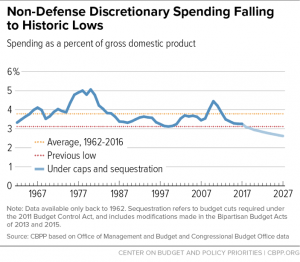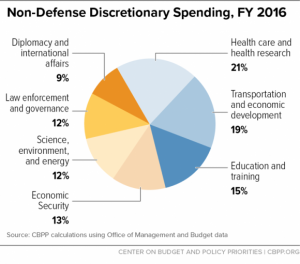September 28, 2017
5 Things to Know about the Current State of Science Funding
Posted by bwebster
Sequestration (a.k.a. Major Government Cuts) Kicks-In in January
The Budget Control Act of 2011 (BCA) required Congress to find ways to cut the deficit by capping funding for non-defense, including science, and defense programs. Congress never came to an agreement on ways to cut the deficit and therefore automatic across the board cuts for government spending, or sequestration, were invoked. Sequestration was supposed to be so bad that Congress would be forced to reach an agreement. 
Congress has twice passed an agreement that offered relief from sequestration, and the second agreement expires this year. Sequestration for government funding will begin in January unless Congress passes a budget agreement that provides additional money for defense and non-defense programs. Without a budget agreement, it’s likely that most science agencies will recieve a cut in funding in 2018.
The Current CR is Hurting Agencies and Science
A continuing resolution (CR) funds agencies at the previous fiscal year’s levels. Under a CR, agencies cannot begin, alter, or eliminate any existing programs. In September, Congress passed a CR that expires on 8 December.
Each year, science agencies plan to construct or update new facilities and satellites, end initiative and begin new initiatives, and retire and start missions. All of this is disrupted when Congress passes a CR and fails to complete the appropriations process. Additionally, suspending plans, even temporarily, often leads to increased costs of projects and initiatives. Continuing resolutions make it difficult for agencies to plan for the year, hurts science, and the scientists who participate in these projects.
Parity between Defense and Non-Defense is Vital for Strong Science Funding
Under the Budget Control Act, there’s a limit to how much money Congress is allowed to spend through the appropriations process. The parity principal ensures that funding for non-defense programs (including funding for federal science agencies) is increased by the same amount as funding for defense programs.
Increasingly, the federal budget is dominated by spending on mandatory programs, like Social Security, Medicare, and interest payments on the national debt. This shrinks the size of the pie available to Congress to allocate through the appropriations process. In order for science, and other non-defense programs to see any growth in funding it is imperative that Congress continue to require parity between defense and non-defense programs in the appropriations process.
Members of Congress Like Science but Need A Reason to Protect It
When meeting with Congressional offices, the most common refrain we hear is encouragement to keep reaching out to other members, especially members who do not sit on committees that handle science. Members who sit on committees whose jurisdiction includes science, often develop an appreciation for science and understand the need for continued government investment in science, even without clear payoffs. However, what about the majority of legislators who don’t?
Those are the members of Congress who need attention. Overwhelmingly, we hear from offices that they love science, think it’s cool, and can’t wait to see what will be discovered next. But how do we turn that enthusiasm into increased investments and higher prioritization of science? By repeatedly meeting and highlighting how science is critical for the legislator’s district and constituents; by making science real and tangible for lawmakers.
You Can Take Significant Actions Now
The most significant actions you can take to ensure robust funding for science involve direct outreach to your members of Congress. Meet with them or their staff, call them, attend one of their events in the district, or write them a letter.
No matter how you reach out to your member of Congress, you should identify yourself as a constituent, discuss how science and your work benefits your local community and the nation, and why robust funding for science is essential for your work and our nation’s scientific endeavor.
Don’t wait till December act, reach out to your members of Congress today!
You can do act right now! Our current funding campaign only takes a few minutes.
AGU also has several tools to aid your outreach and the Public Affairs team is available to help you. Contact us at [email protected] and someone will get back to you shortly.









